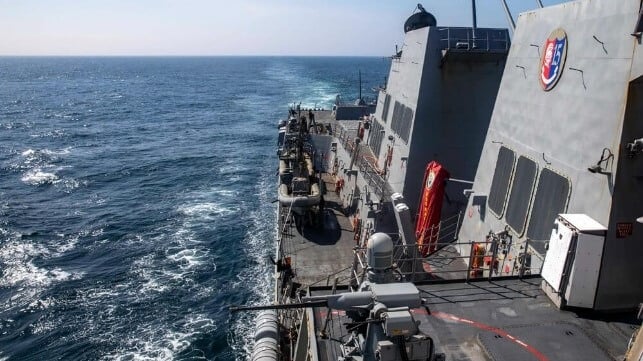China Reacts Angrily After First U.S. Transit of Taiwan Strait Under Trump

Less than a month into the new Trump administration the U.S. conducted what it calls a “freedom of navigation” exercise sending two U.S. Navy vessels through the politically sensitive Taiwan Strait. Chinese spokespersons reacted angrily in what they perceived as a show of force and a possible signal of the new Trump administration's stance toward China.
China continues to aggressively press its reunification claims for the island saying it would only wait so long. Chinese nationalists have controlled the island since 1949 and the declaration of the People’s Republic of China. They reject the demands of the communists saying the island is independent, and its fate is controlled by the people.
The U.S. frequently sends vessels or aircraft through the strait. Media reports suggest the U.S. conducted transits eight times in 2024, with the last vessel going through the strait in October and a plane overflying the strait in November.
“The transit occurred through a corridor in the Taiwan Strait that is beyond any coastal state’s territorial seas,” said Navy Commander Matthew Comer, a spokesperson at the U.S. military’s Indo-Pacific Command reporting this week’s transit.
The U.S. Navy did not provide extensive details. It simply said a guided-missile destroyer, USS Ralph Johnson, and a Pathfinder-class survey ship, USNS Bowditch, made the transit between February 10 and 12. Ralph Johnson, assigned to the 7th Fleet and Indo-Pacific Command, had made a similar transit in August 2024.
“Two U.S. naval vessels sailed through the Taiwan Strait from north to south starting on the 10th. During this period, ROC Armed Forces maintained full control over the surrounding sea and airspace, with the situation remaining normal,” reported the Ministry of National Defense, ROC (Taiwan). It regularly monitors the activity and reports that 30 PLA aircraft, 7 PLAN vessels, and 1 official ship were detected around Taiwan.
“The U.S. action sends the wrong signals and increases security risks,” said a spokesperson for the PLA. It noted that its forces are on constant high alert while saying its navy and air force were deployed to “monitor the whole process of the U.S. vessels’ passage and effectively managed the situation.”
It is the second regional activity by the U.S. this month. The U.S. Navy highlighted a planned exercise involving the Royal Australian Navy and the UK Royal Navy sailing with a U.S. ship in the South China Sea. It took place between February 6 and 7 involving the guided-missile destroyer USS Benfold, RAN Hobart-class guided-missile destroyer HMAS Hobart, and RN River-class offshore patrol vessels HMS Spey.
“Regular military engagements between the defense forces in the Indo-Pacific will help maintain regional security and stability,” said Commodore Jonathan Ley, Joint Force Maritime Component Commander for Australia’s Headquarters Joint Operations Command.
According to the statement issued on the exercise, the three ships practiced their ability to exchange data using their tactical datalink systems, while the maneuvering exercise trained the crews’ ability to sail alongside each other in various conditions, improving the self-defense and communication capabilities of the three countries.
China regularly monitors these exercises. It issued a statement this week highlighting its own exercise saying it participated in a multi-country event organized by Pakistan.
